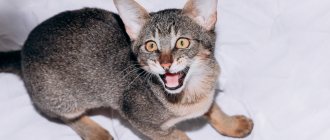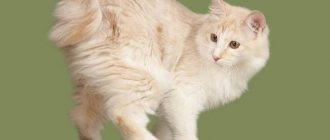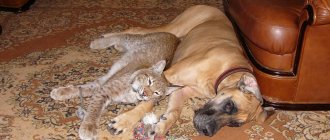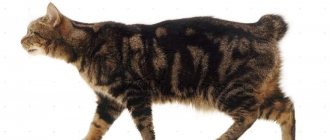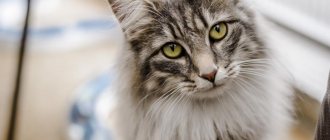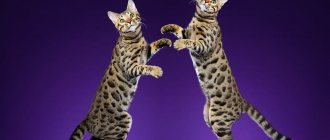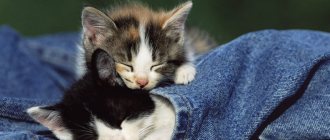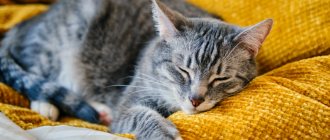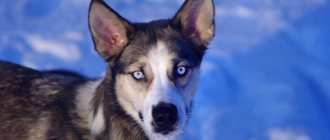The Hausie cat (Chausie) is a hybrid of a domestic and wild animal. Cats differ from their counterparts in appearance and character. The uniqueness of the breed is due to the presence of wild ancestors.
Few breeders are involved in breeding Hausie cats, since the crossing process is labor-intensive and often does not bring the desired result. Keeping animals of this breed is also very troublesome and expensive.
Brief history of the Chausie cat breed
The first hybrids of a domestic cat and a jungle cat began to appear during the times of Ancient Egypt. Although such animals harmoniously combined wild appearance and docile disposition, the inhabitants of the land of the pharaohs were in no hurry to recognize them as a unique breed.
Judging by ancient frescoes and surviving documents, both the jungle cats themselves and their descendants were of no small importance for the Egyptians. They lived next to people and helped them hunt small rodents and waterfowl.
At the end of the era of the pharaohs, extraordinary cats still coexisted in symbiosis with humans, but did not attract the attention of scientists of that time. Everything changed when American tourists saw them.
In 1960, these cats came to the United States and began to participate in breeding work to develop a breed with the exterior of a wild animal and the character of a domestic pet.
The most successful in this regard was a cross between an Abyssinian cat and a jungle cat. In 1995, the Chausie was given provisional status by TICA. And in 2003 the breed was officially registered.
What is the difference between Chausie f1 and f2
This breed is divided into hybrid categories, which are designated by the letter F and numbers 1-5. The number indicates the percentage of jungle cat blood.
The F1 hybrid is the most valuable option, considered a direct descendant from the mating of a Housey and a noble cat. It's about 50% wild cat. In appearance, the animals are almost identical to dad. And they are very similar in temperament: active, rebellious, sometimes aggressive. Large in size. Also denoted by the letter A.
Hybrid F2 - comes out as a result of crossing the first option with a descendant of Chausie. The content of wild blood is not less than 25%. This is the most common breed. The weight of the animal is 10-11 kg. Cats are endowed with a democratic character. The hybrid is also marked with the letters A or B.
Males of the first and second types do not participate in the reproduction of offspring.
Interesting Facts
Although Chausie cats have only recently been recognized, a lot of interesting things have happened to them:
- The name of the breed directly indicates its relationship with jungle cats, known in scientific circles as Felis chaus.
- In some countries, representatives of the breed are called Hausie, Swamp or Nile cats.
- Chausie F1 males are completely sterile and are not capable of procreation. The first full-fledged cat was a representative of the third generation named Tasurt Naabhi. He gave birth to numerous offspring and appears in almost all pedigrees of modern Chausies.
- Representatives of the breed are divided into several species, the main difference between which is the ratio of wild and domestic blood. Chausie F1 has 50% of the jungle cat genes. They cannot be fully domesticated and can be dangerous if not handled correctly. F2 generation Houses have 25% wild blood. These cats have a calmer temperament and are easier to tame. Chausie F3 have 12.5% wild genes. In character and appearance they bear little resemblance to a jungle cat. Chausie F4 and F5 each have 6.25% and 3.12% wild blood. Such cats have a calm, peaceful disposition and can be domesticated without any problems.
Breeding and organizing a chausie nursery
Breeding Chausie is allowed only to people with a felinologist diploma and who understand all the nuances of the breed. Therefore, before taking on this difficult task, you need to attend felinological courses and consult with professionals in this field. It would also be a good idea to spend some time breeding Abyssinian cats, since breeding Chausie cats is allowed only in professional nurseries with responsible breeders.
Breeding Chausie has several disadvantages:
- Firstly, cats of this breed are extremely expensive. In order to buy a pair for breeding, you will have to shell out at least half a million rubles, and to purchase a jungle cat, with which it is best to start breeding Chausie, you will have to shell out at least eight hundred thousand.
- Secondly, this is a very risky business, since the breeder faces many difficulties: infertility and mutations in kittens, inbreeding and many others.
- Thirdly, this business is designed for a very narrow category of people who can afford to spend 200,000 rubles or more on a cat.
But if you have sufficient funds, knowledge and experience and are not afraid of difficulties, then it is quite possible to try. But remember: cats must be purchased only from a specialized nursery with all licenses.
The Chausie breeder will have to work hard to get a cat that fully meets the standard.
Mating
For a novice breeder, the best choice would be an F1 generation cat. Breeding chausie involves many difficulties and nuances:
- Chausie cats up to the third generation are born infertile. Therefore, if you want to buy a couple of studs, then you need to take an F1 female and an Abyssinian cat.
- When you have already gained experience, you can also buy a reed kitten, always a male, since a wild female will not let a domestic cat near her. It should be crossed with an Abyssinian cat. A jungle cat may not agree to a proposed mate, so you may have to go through several females.
- The F2 female is also bred to an Abyssinian cat.
- Make sure your cats are blood type compatible. Cats have only two groups: A and B. Cats A and cats B are compatible with any partner, cats B are mated only with males B, males A are mated only with females A.
First generation Chausies love to hunt
Pregnancy
Some features of pregnancy during breeding should also be taken into account:
- The pregnancy of an Abyssinian cat from a jungle cat will last about 67–70 days, and she will bring two or three kittens. Moreover, some of them may not meet the standard and look more like an Abyssinian cat than a wild cat.
- A female Chausie F1 and F2 will give birth to about 3-4 kittens, which may also not meet the standard.
- Chausie males cannot have offspring until the third generation, so the boy can be sold under the F1 label if he is the son of a jungle cat and an Abyssinian cat; F2, if he is the son of an F1 female and an Abyssinian cat; F3, if he is the son of a Chausie F2 and an Abyssinian cat.
- Only Chausie females that fully comply with the standard are allowed to be selected for further breeding.
As you can see, breeding chausie is a very difficult matter. Only people who have the necessary knowledge and are ready to devote all their time and even their lives to chausie can achieve success.
Chausie needs an owner who can devote a lot of time to them
Note to the breeder
Before you start breeding Chausie, you need to obtain permission to breed Chausie and register the nursery.
- The breed is recognized only by TICA. Therefore, the nursery must be registered there.
- Each cat, both Abyssinian and Chausie, must have a breeding rating of at least “excellent” in the open category or a title certificate. You can get them at the exhibition.
- Each cat must have a confirmed pedigree.
- For each kitten, a birth certificate and a breeding sheet are issued, which is assigned a four-digit number. If you have a felinologist diploma, you can do this yourself.
- Chausies receive the same vaccinations as regular cats. Kittens receive a veterinary passport from 3 months.
Breed description, standards, appearance
Chausies are harmonious, proportionally built cats with well-developed muscles and long, strong legs. Despite the fact that Abyssinian blood flows in their veins, they are distinguished by their large size. The standard, which provides a complete description of the Chausie breed, was developed in 1995.
Dimensions and weight
Due to their relationship with true predators, Chausie cats have impressive sizes. The female's weight is 9-13 kg. The male weighs 10-15 kg. The height of the Hausi ranges from 40-50 cm at the withers, and the length of the body with tail reaches 1.55 m.
Anatomical characteristics
According to the official description, Chausie cats should look like this:
- The head is wedge-shaped, moderately elongated, elegantly outlined, small in comparison with the body. The forehead is wide and flat. High cheekbones. The occipital protuberance is well defined. The muzzle is neat, with a fairly sharp stop. The cat's nose and chin form a straight line. Male chausies have a wider bridge of the nose than females.
- The ears are large, wide at the base, set high and far, with pointed tips, decorated with neat tassels. On the outside of the Chausie's ears there are false "eyes" - small spots inherited from Egyptian relatives.
- The eyes are almond-shaped, closely spaced, slightly slanted. The iris of the Chausie can be a rich yellow, amber or yellow-green hue.
- The body is tightly built, with heavy bones, developed muscles, a deep broad chest, a straight back, a moderately tucked groin line, a short thick neck, narrow shoulders and pelvis.
- The limbs are long, muscular with large paws and loosely gathered toes.
- The tail is mobile, smooth, wide at the base.
Color and coat type
Chausie is a cat with short hair that visually resembles plush. This effect is achieved due to the fact that the animal’s villi adhere tightly and densely to each other. The shiny guard hair of the Housie shimmers in the sun and hides a well-developed undercoat.
The standard allows the following colors of Chausie:
- Black – the fur is evenly colored charcoal. The body of the Hausi is completely free of spots and marks.
- Ticked black tabby - the fur is colored in several tones. The golden-red color of the undercoat is combined with the points on the inside of the legs and tail of the cat. The Housie has lighter hair on his chin and around his eyes.
- Black and silver ticked tabby. The guard hair of the Chausie has dark tips. Each of them has 2-3 ticking stripes in black and silver. The presence of bright points on the body of a Hausi is regarded as a disadvantage.
On a note. Sometimes Housies are born with a different coat color. Such cats are less in demand and are not used for breeding.
Care for claws, teeth, eyes, ears
Caring for the ears, teeth and eyes of the Chausie is not too different from caring for other domestic cats:
- The ears are cleaned every five to six days with special drops for cleaning the ears. Place a few drops into your ear and gently massage the base of the ear for 2-3 minutes.
- The eyes should be cleaned daily with a cloth soaked in warm water. You need to wipe in the direction from the inner corner to the outer.
- Teeth are cleaned using a silicone toothbrush and toothpaste for cats. The joints of the teeth and the area near the gums are most thoroughly cleaned.
- A simple scratching post will not work for Chausie's claws: they will need a wooden log. Nails need to be trimmed as they grow - buy a nail clipper for this. The claw is cut slightly at an angle, so that the cut from the front resembles the tip of a nail and does not affect the pink sensitive part of the claw. If the claw bleeds after trimming, treat the wound with peroxide.
Chausie claws are powerful and long, so anti-scratch treatments are ineffective for them.
Character and temperament
Despite their relationship with a predator, Chausie cats are endowed with a cheerful and sociable disposition. They become very attached to their owners and show them their affection in every possible way. Houseies have developed intuition and often accurately guess the wishes of their owners, for which they are called telepaths.
On a note. Houses of the first and second generations with a large admixture of wild blood have an independent and obstinate character. Therefore, those who want to get a softer and more flexible pet should get a fourth generation kitten.
As a reminder of their kinship with wild cats, the Chausie still has the habit of storing supplies in secluded places. Moreover, this can be not only products, but also any things they like. Therefore, Hausie owners often find cat hiding places during the cleaning process.
Sociable animals easily find a common language with children and take an active part in joint games. True, kids should treat the pet with respect and not hurt it. If children decide to pull the Chausie's tail or ears, the cat may become aggressive.
Representatives of the breed get along without problems with their brothers and small dogs. True, for greater safety, it is advisable to accustom the Hausie to the company of other animals from an early age. But a cat will never be able to make friends with small pets like hamsters or aquarium fish. Chausie has excellent hunting instincts and will regard rodents or birds as living “toys” or prey.
Description and features
The very first Jungle Cat “gave” the appearance and breed to subsequent descendants. He gave the features by which we now recognize the Chausie: a stately, athletic build, large ears with small tassels. On the back of the ears there are characteristic spots, “deceptive eyes”.
They seem to be saying to those behind him: “My back is to you, but I see everything!” Massive head with bright yellow or emerald eyes. The soft, short fur shimmers and shines in the sun. It is dense in appearance and elastic to the touch. The tail is quite long and thick. A slender, tall breed, a sort of “puma in miniature.”
Chausies are sociable and active. They are curious, independent, and very active. It was not possible to completely remove the “wildness” from the character, but this gives them a special zest. They do not like to be held, but at the same time they are very sociable and affectionate, and become attached to people. They do not tolerate loneliness well. It’s good if there are other animals in the house, cats quickly find a common language with them, they are sociable and friendly.
They communicate with children as equals, but it is advisable that the child understands that this is not a soft toy, but a full member of the family. These cats demand the respect they deserve. They jump and climb well, they have a highly developed hunting instinct, and they are fearless. They get used to their owners quickly and are very loyal to them. The Chausie cat is larger than a cat of its own breed, like a real “man”. An adult male can be the size of a small dog.
This pet loves to play, so keep toys for him in the house, otherwise he may choose inappropriate items for himself. Be careful if there are hamsters or other small animals or birds in the house - he may mistake them for a toy. The owner whose Chausie lives in his house must be prepared that his pet knows his home better than he does.
He will check every corner. Keep an eye on him during games, he is a big animal after all. The voice is quiet, insinuating, even purring, and then quietly. The dignity of the wild predator here again comes to the fore. He is loyal to guests, however, do not leave them alone, it is unknown how he will react to the caresses of strangers.
The character of the chausie is tenderness and independence in one bottle. He is peaceful and affectionate, but at the same time he never completely obeys a person. All of our own free will. If he receives enough attention, you will see his best qualities - nobility, poise, sociability, amorousness.
He truly “falls in love” with his owner with all the ensuing consequences - he caresses him, rubs himself near his legs, purrs tenderly. He will not accept betrayal. It is impossible to give it into other hands. Having such a cat in the house is a true pleasure for connoisseurs; he will become a true dear friend in every sense of the word.
How to choose the right kitten
The Chausie breed belongs to the category of rare and very expensive. A little more than 20 nurseries specializing in breeding these cats are registered with TICA. Moreover, the majority of Hausie breeders live in France and the USA. In order not to become a victim of deception and not to purchase a mestizo or outbred animal, you should not contact the first nursery you come across. And when choosing a Hausie kitten, you should pay attention to the following nuances:
- availability of pedigree and veterinary passport;
- health status;
- compliance with the breed standard;
- behavioral characteristics;
- conditions of detention.
Important! When purchasing a Chausie kitten, a special contract is usually drawn up, which stipulates the possibility of participation in exhibitions and specifies issues of breeding use.
Kitten care
Not a single reputable breeder of this breed of cats will sell Chausie before three months of age. By this time, the kitten will have already received preventive vaccinations, become accustomed to solid food, and learned basic self-care skills. Therefore, new Hausie owners will not have any special problems caring for him.
To prevent a curious pet from harming itself, electrical wires, a first aid kit, cleaning supplies, indoor plants and small fragile trinkets are removed from it. You need to be especially careful with kittens of the first and second generation, since these are the ones who are more prone to mischief and adventure than others.
Coat colors
Dark color Chausie
The peculiarity of such cats is their color. The guard hairs are unevenly colored in certain areas of the body. The standard provides several colors:
- Resinous. The animal is almost completely black. There are rarely any markings.
- Tecked black tabby. The fur is multi-colored, the undercoat is of a reddish-golden hue on the paws and tail along the inner surface. The chin and eye contours are lightened.
- Black with silver. The guard hairs have several stripes, usually silver or black. Deeply colored points in tabby will be considered a defect.
- In addition to the listed colors, there are others, but they are less popular. Such individuals are not allowed to reproduce.
Care and maintenance
Chausies are active and lively cats that cannot live in a confined space. Representatives of the F1 and F2 generations should be kept in private houses with an equipped enclosure. Houseies with a small admixture of wild blood can be accommodated in spacious apartments.
Unlike representatives of many other breeds, these cats are not afraid of water and love to swim. Therefore, if you wish, you can equip a chausie with a small pool with clean water. Otherwise, caring for cats of this breed comes down to keeping their teeth, eyes, ears and coat clean.
Hygiene procedures
To ensure that a Hausie cat always has a neat appearance, it is regularly sanitized:
- The eyes and ears of the animal are systematically wiped with cotton pads soaked in a special product without ethanol.
- Chausie's claws are trimmed with a nail clipper as they grow. Only the transparent ends are removed and do not touch the blood vessels. To prevent the cat from damaging furniture and wallpaper, it is taught to use a scratching post from an early age.
- To prevent plaque from accumulating on Hausi teeth and tartar from forming, they are cleaned 2-3 times a week with a non-foaming paste and a special silicone attachment or a soft brush.
Grooming
The short fur of the Chausie does not require complex grooming. To maintain a neat appearance and improve blood circulation, the cat's fur is brushed weekly with a massage brush.
Bathe the Chausie as it gets dirty using special shampoos for short-haired breeds. Since this cat's skin is covered with special oil, frequent washing is contraindicated.
Tray
A spacious closed tray is ideal as a toilet for a chausie. When choosing a litter, it is better to focus on the preferences of the cat itself. Although many breeders recommend using clumping varieties that absorb odors well and do not stain the Howie’s paws.
On a note. It can be difficult to toilet train a Chausie, especially if we are talking about kittens with a large admixture of wild blood. But with some persistence from the owner, this problem can be solved.
Health and illness
Chausie is distinguished by truly heroic health. Although the cat is heat-loving, it is not afraid of light frosts and does not get sick from the slightest draft. Chausie also has quite sensitive digestion. The only disease these cats are prone to is obesity.
Obesity
Obesity in the Chausie occurs due to its exorbitant appetite. Chausie can literally eat non-stop. The owner needs to stop begging, otherwise the cat will quickly turn not only into a kind of ball on its paws, but also into an eternally hungry meowing tail that does not disdain to steal food from the owner’s table.
Symptoms of obesity:
- The cat's weight is 20% or more higher than normal.
- Severe shortness of breath with little activity.
- Mobility problems.
- Inability to feel the ribs or spine through the fat layer.
Chausie loves to beg, but he can be weaned from this habit by simply ignoring the behavior
What causes obesity:
- Genetic predisposition.
- Uncontrolled eating.
- Hormonal disbalance.
- Lack of sufficient physical activity.
Obesity is much easier to prevent than to cure. To do this, the cat must be provided with maximum physical activity and proper, balanced feeding. But if the cat does get sick, then treatment involves diet, physical activity and, if necessary, taking hormonal medications.
Feeding the cat
Chausie inherited from its wild ancestors a shortened intestinal tract, not adapted to fully digest fiber. Therefore, it is undesirable for representatives of the breed to be fed plant foods and industrial feeds.
Complete diet
The basis of the chausie menu should be raw lean meat such as rabbit or beef. Several times a week, your cat’s diet can be varied with quail, chickens or ocean fish. For mechanical cleaning of teeth, it is recommended to give chausie tendons and cartilage.
It is prohibited to include in the daily menu of a cat of this breed:
- pork;
- milk;
- potato;
- beans;
- nuts;
- mushrooms;
- confectionery;
- sausages;
- liver;
- any dishes from the host's table.
Feeding frequency
Unlike ordinary domestic cats, Chausie cats are taught to eat twice a day from a young age. And from 12 months they are fed once a day.
Vitamins and minerals
With proper nutrition, the Hausie does not need additional mineral supplements. Any vitamin complexes are given to cats of this breed only after consultation with a specialist.
Nutrition
Not the easiest question in keeping a mini cougar. They have an insatiable appetite and a sensitive digestive system. For example, they may react poorly to grains, which are included in many commercial foods. Pork is a strictly prohibited product. Therefore, special attention should be paid to diet.
You can feed him natural meat, only dietary meat. This can be raw beef, various fish and rabbit meat. You can give chicken, quail, and raw quail eggs. Be prepared that he will consume large quantities of animal food.
In addition, you must add the necessary carbohydrates and microelements to your diet. Daily feeding should be done no more than twice before a year, and after a year - once a day. They even recommend arranging fasting days. Still, he moves much less at home than his wild pedigree requires. It is also recommended to feed Chausie with premium food (no grains!) or holistic food.
Holistic ("holistic" food) is a new generation of food that is made from products intended for people. Fresh meat and fish, fresh fruits and vegetables instead of processed foods and fillers. The composition is absolutely natural, without preservatives, dyes, artificial additives and fragrances.
Cats primarily eat animal meat. They perfectly digest all the nutritional components of meat, but they do not cope so easily with carbohydrates. However, they are necessary in reasonable quantities. The optimal carbohydrates for pussy are boiled brown rice and oatmeal.
Tapioca (a grainy, starchy product made from the roots of cassava, a South American spurge), sweet potatoes, or fresh fruits and vegetables are also good options. The menu should only contain no more than 10% carbohydrates.
Holistic food takes these proportions into account, adding dried fruits and vegetables as prebiotics, as well as desirable minerals, omega acids and vitamins - categories of substances necessary for normal digestion. Everything that makes a cat healthy, its fur beautiful, and its mood cheerful.
You will have to read the labels carefully. If a food contains foods that are unknown to you, or you cannot identify, or they do not fit into the categories listed above, the food is incorrectly labeled as holistic.
Attention! Your pet's water should be filtered or boiled. Raw water is contraindicated.
Education and physical activity
Chausies are smart cats with high intelligence and good memory. If you show a little patience and perseverance, you can teach them not only the rules of behavior in the house, but also simple commands. The main thing is to praise the Hausi more often for his successes and do not forget to reward him with a treat.
To prevent the cat from getting bored while waiting for its owners, it is provided with a variety of toys, balls and a sports corner. And to maintain good physical shape, Chausie needs regular walks.
Positive and negative traits
Unique creatures for extraordinary people
Any breed has its own advantages and disadvantages. Chausie is no exception. The benefits include:
- get along easily with other household inhabitants;
- treat children with love;
- in the excitement they will not scratch the owner;
- atypical appearance;
- endowed with excellent health;
- sociable, cheerful and lively;
- undemanding in terms of attention.
The disadvantages include:
- are expensive;
- rare (in Russia such representatives can be counted on one hand);
- need a lot of space;
- Infertile cats are often born;
- require a special approach to nutrition, since they cannot eat fatty meats and grains, and raw water (only filtered or boiled) is contraindicated for them;
- cannot stand being alone for a long time, otherwise they begin to damage the furniture, wallpaper and other attributes in the interior;
- are predisposed to gaining excess weight with a sedentary lifestyle;
- expensive to maintain and care.
Vaccinations and antiparasitic treatment
To protect Housies from common feline infections, they are regularly vaccinated. The first time a kitten is vaccinated against rabies, panleukopenia, rhinotracheitis and calcivirosis at the age of 7-8 weeks, with a mandatory repeat after 28 days. Subsequently, Chausie is vaccinated once a year.
To kill fleas and helminths, the cat is regularly given antiparasitic treatment. Antihelminthic drugs are given to the Hausi twice a year, repeated every 10-14 days. To combat fleas, a cat of this breed is treated with special shampoos or drops.
Conclusions about the breed
global $ads_google;
//data-ad-slot=”2475549904″ $ads_google = empty($ads_google) ? false : true; ?> if ($ads_google == false) {?> $ads_google = true; ?> } ?> So, who should own a chausie and why?
- active family with other pets, but preferably without small children. They are kind, affectionate and obedient, but from time to time they are unpredictable and are able to show their ambition.
- owners of private houses. Chausies are excellent guards and hunters. Of course, they are not as good as dogs, but a mouse or an uninvited guest will definitely not get into your home.
- those who are not ready to spend significant sums of money on care and treatment of diseases. Only a few things (meat table, walks, bathing and socializing with people) are enough to make your pet happy.
Pros and cons of the breed
Like any other breed of cat, Chausie cats have their advantages and disadvantages.
| pros | Minuses |
| Exotic appearance | Rarity of the breed and high cost |
| Good health | Difficulties in breeding Hausie |
| Good learning ability | Expensive content |
Chausies are exclusive cats with an interesting appearance and a dash of wild blood. They are highly valued among professional felinologists and will become excellent companions for those who are able to provide them with decent living conditions.
a brief description of
An extraordinary cat breed
The Chausie breed can be briefly described as follows:
| Index | Rating on a 5-point scale |
| Interaction with children | 3 |
| Attitude towards strangers | 3 |
| Financial costs of maintenance | 4 |
| Health status | 4 |
| Price | 5 |
| Dietary requirements | 2 |
| How much do they shed? | 3 |
| Difficulties in care issues | 3 |
| Need for communication | 2 |
| Aggression level | 3 |
| Mobility | 4 |
| Intellectual development | 4 |
| Dimensions | 5 |
| Cleanliness | 3 |
Chausie's characteristics are compiled based on reviews from owners and expert opinions. The information is averaged and may change in one direction or another.
Animal color
The fur of the Chausie cat can be seen in the photo. It is quite dense, but soft and pleasant to the touch. In healthy individuals, it has a characteristic sheen and very warm fur and has a barely noticeable striped color.
The main distinguishing feature is the tip of the tail and tassels, painted black. And on the neck there should be darkening in the form of a “necklace”.
A true chausie usually has at least two colors. In order not to make a mistake in choosing a cat, it is important to know the types of coat colors! There are only four of them:
- Black
- Silver
- Dark brown
- Ticked.
Origin story
The Chausie kitten was created in the USA in 1995. First of all, the researchers wanted to get a domestic cat with a wild appearance. To do this, they crossed a jungle cat (swamp lynx) with a domestic cat. The resulting breed was called the Hausie. Other pronunciation variations include Chausie, Chausie and Chausie.
The Chausie cat is imbued with respect for its owner
The jungle cat is a type of predatory mammal. It is a large animal weighing about 12 kg. The habitat of these cats is reed beds surrounded by water. The species first appeared about 10 thousand years ago. The first domestication of wild cats occurred on the territory of the Sumerian civilization. Then the pets ended up in Egypt, where they continued to be domesticated.
The habitat of the jungle cat is from Transcaucasia and extends to China
For your information! The Chausie breed received official status in 2003. It is very difficult to find such a cat in Russia. The majority of individuals live in the USA and France.
Description and appearance
The Chausie cat has a slender and elongated body with long, strong legs. This structure is designed to overcome heavy obstacles and large jumps.
A purebred cat has the following description:
- The head is medium-sized and wedge-shaped. The muzzle is long and slightly elongated. High cheekbones frame a soft chin;
- the forehead is long with arching eyebrows. The nose is slightly raised at the end, forming a convex lobe;
- almond-shaped eyes of medium size with an oriental slant. Rounded below and straightened above. Acceptable eye shades: brown, green, yellow, gold;
- ears are high and large. Wide at the base and gradually tapering towards the end. Some species have ear tufts;
- neck of medium length;
- the body is large, rectangular, not wide, but muscular. The paws are long with oval pads on the toes;
- the tail is not too long, tapering towards the end;
- Standard colors of the breed: black, black and silver and black ticked tabby. The coat is short, there is a soft undercoat;
- The main difference between males and females is weight. Male representatives weighing from 12 to 18 kg.
Castration and sterilization
If you do not set yourself the goal of breeding the breed, then it is necessary to undergo a sterilization operation. In many countries, this operation is a requirement for keeping non-breeding pets. This has been proven time and again to be the most humane way to treat your pets. Moreover, this operation must also be carried out with sterile animals.
The best time for surgery: before puberty. This usually corresponds to nine months of age.
Tips for choosing a kitten
Before purchasing a Chausie kitten, you need to immediately understand that getting from him purebred offspring with the characteristics of the parents is out of the question, since the value of the next litter is lost by half. As you move away from F1, the unique qualities of wild cats, their size and weight, decrease.
When getting an elite breed, you need to understand that this is a “disposable” elite pet, and it will not be possible to fully compensate for the costs by selling kittens. In addition, today you cannot buy Housei in the Russian Federation and CIS countries; there are official nurseries only in America and France.
If you are offered to buy a “purebred” Chausie cat on an online ad site, rest assured that you are dealing with scammers. A purebred kitten can only be purchased from an official breeder. To do this, you will have to send an application and wait 3-4 months for the next brood.
It is better to entrust the purchase of a kitten to a specialist with a good reputation. He will contact a time-tested foreign breeder and, with all the accompanying documents, will deliver the baby straight home to the new owner.
Pregnancy and childbirth
During childbirth it is necessary to help the pet
A cat's pregnancy lasts 63–66 days. The duration is counted from the day of coverage until delivery. Kittens may appear earlier. But if babies are born before day 58, they will not be able to survive.
The signs are as follows:
- The first symptoms of pregnancy are weakness and nausea of the cat for 10 days after coating.
- After 3 weeks, you may notice an enlargement and change in color of the nipples, which turn pink.
- There is a change in appetite. The cat may refuse previously loved food.
- At week 6, the abdomen enlarges, and at week seven, fetal movement is already observed.
Important! In the second half of pregnancy, the cat should not be allowed to climb high furniture or jump. During this period, the female’s center of gravity shifts, which makes it difficult to maintain balance.
For childbirth, prepare:
- The box is 50x60 cm in size. On the walls you can build shelves 5 cm wide, where the kittens will subsequently climb. This will protect children from injury. The cat may lie down unsuccessfully and accidentally crush them.
- Place several layers of newspaper at the bottom of the box; they will absorb moisture. Do not use bedding that wrinkles easily. Kittens can become entangled and suffocate.
- During the first week after birth, maintain the temperature in the box at 29 °C, then reduce it every week by 3 °C to a level of 21 °C. This can be done using a thermostat, air conditioner or infrared lamp (250 W).
You also need to prepare:
- towels;
- napkins;
- scissors treated with alcohol.
Signs of impending labor appear 3–4 days in advance. The cat begins to show anxiety, meow, and refuse food. Her body temperature drops to 36–37 °C, her stomach drops. At this time, you should show the cat the box. If the birth occurs in another place, immediately transfer the babies to the box. The cat begins having contractions 1 hour before the kitten appears and mucous discharge is observed. The birth process lasts from 2 to 6 hours. The intervals between the appearance of kittens are 5–30 minutes.
Important! Between contractions, you can offer your cat milk to restore her strength.
Within 15 minutes after the baby is born, the cat gnaws the umbilical cord. If this does not happen, cut it at a level of 2.5 cm from the tummy using scissors. Next, the placenta comes out, which the cat eats. After the process is completed, she is laid on her side, and the babies begin to suck colostrum. This way they receive all the necessary substances that form the kittens’ immunity.
